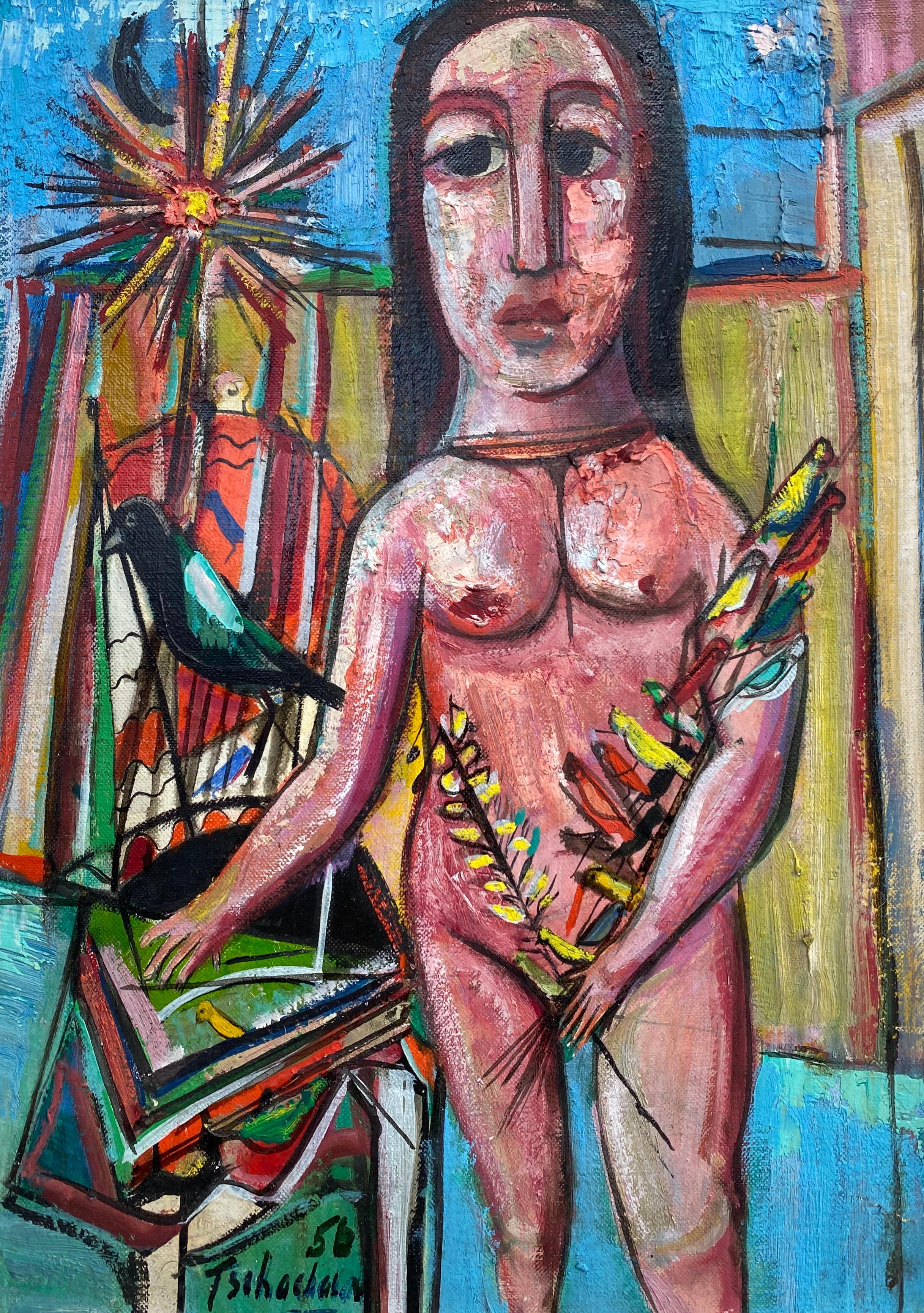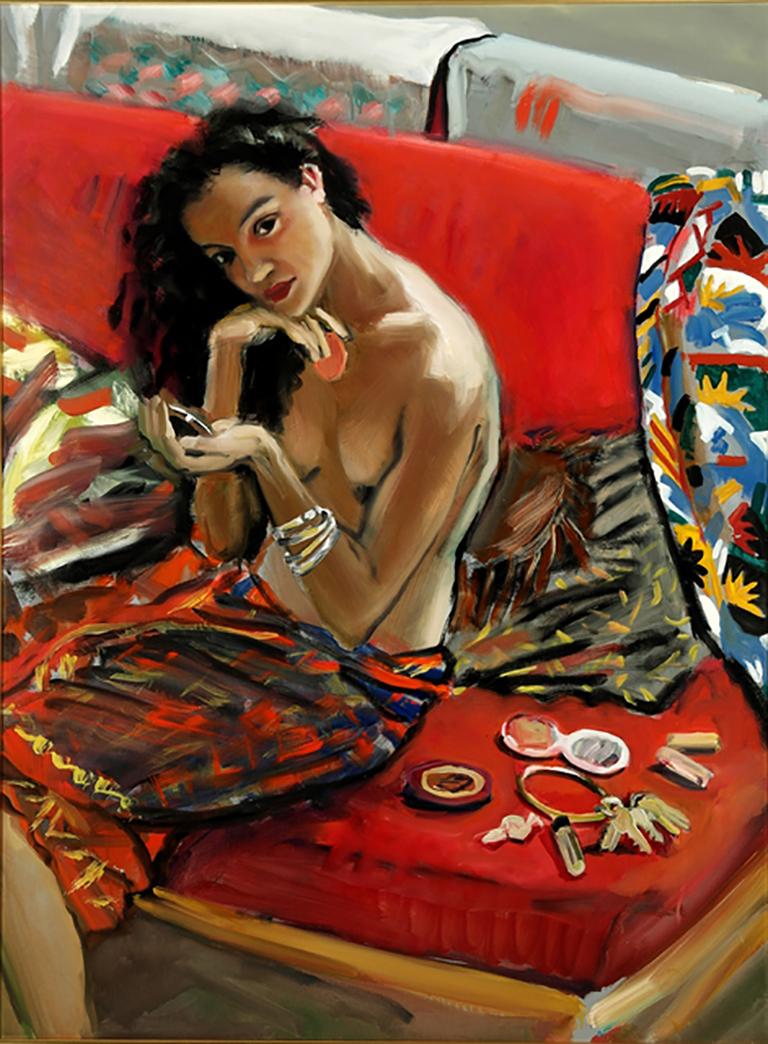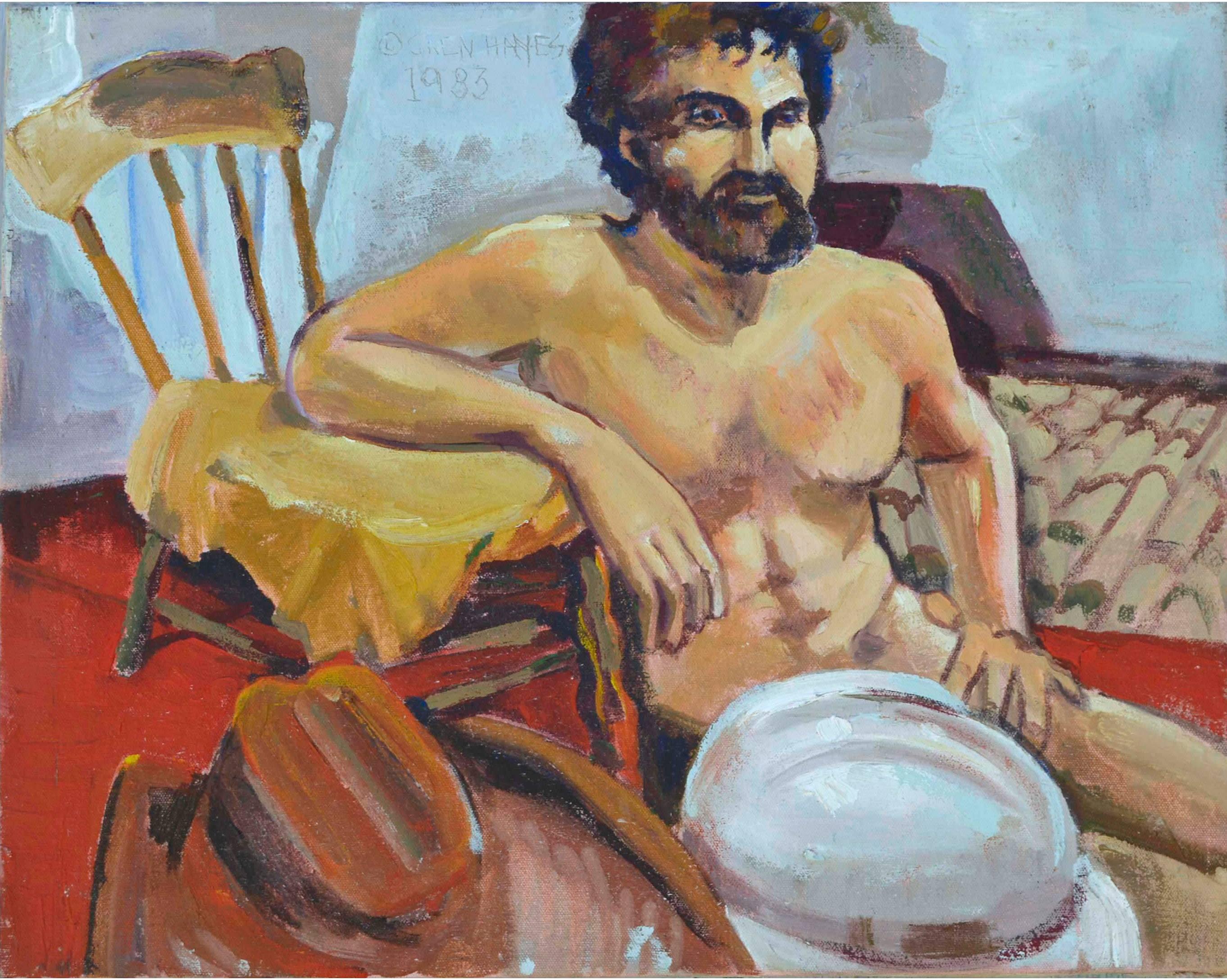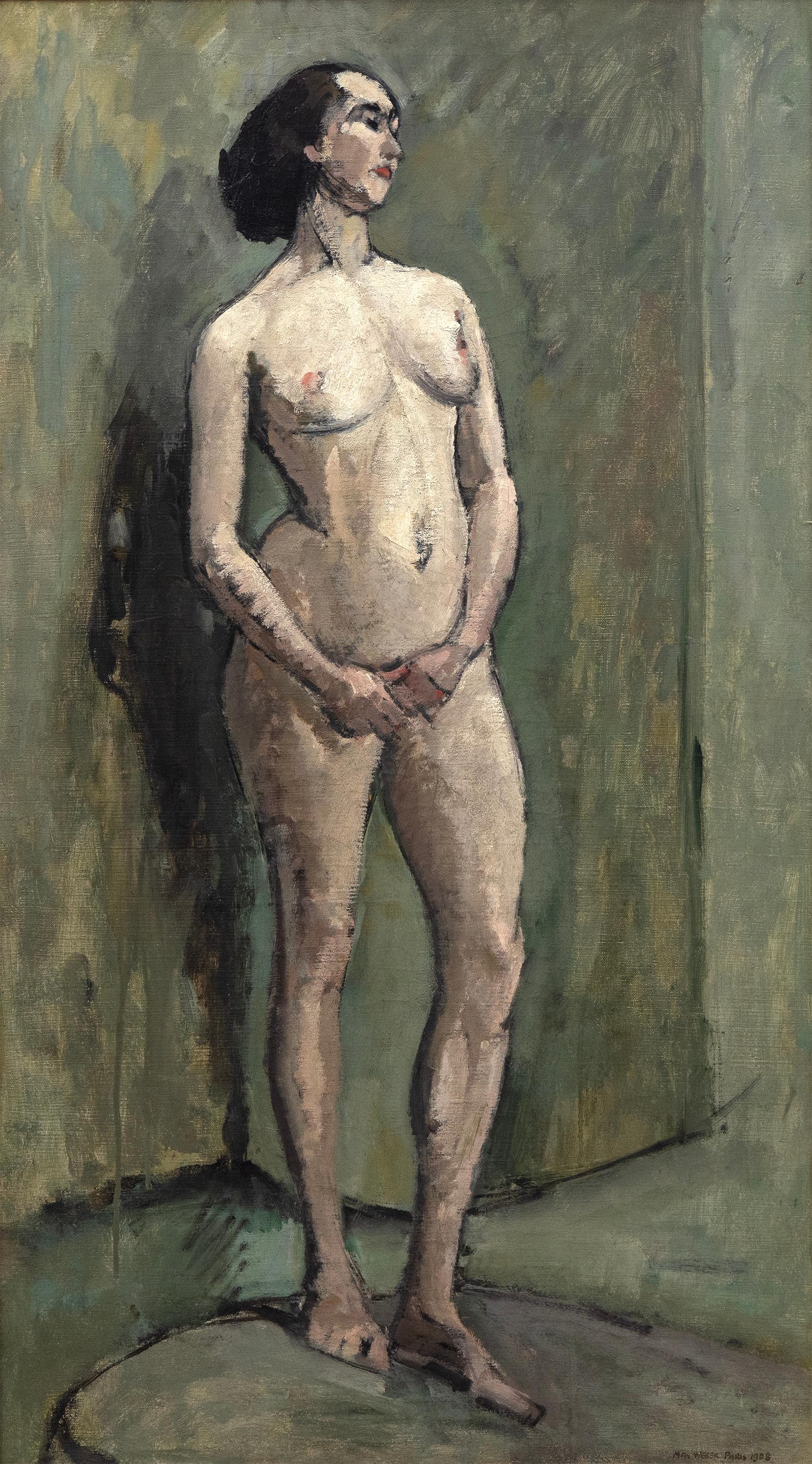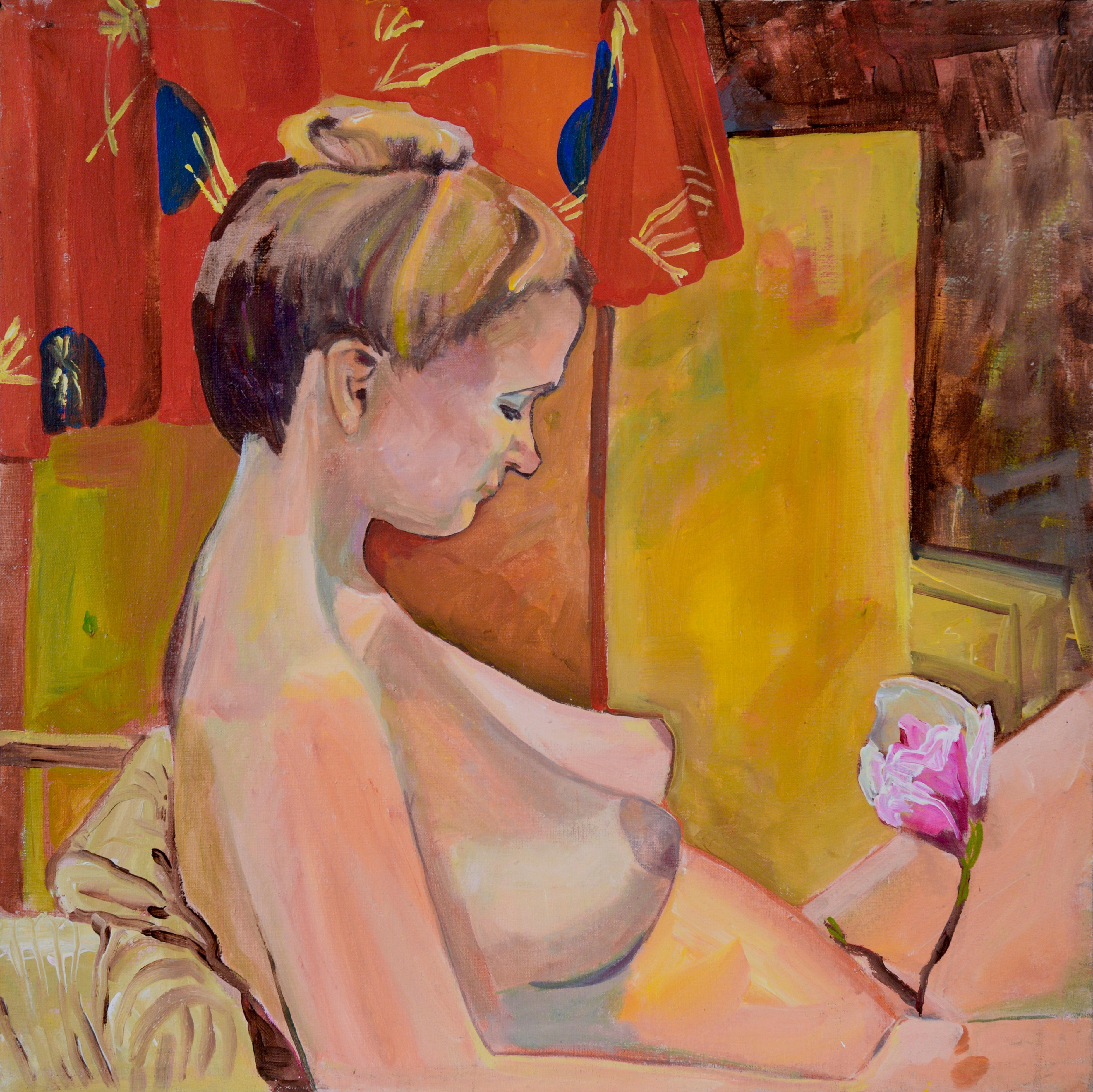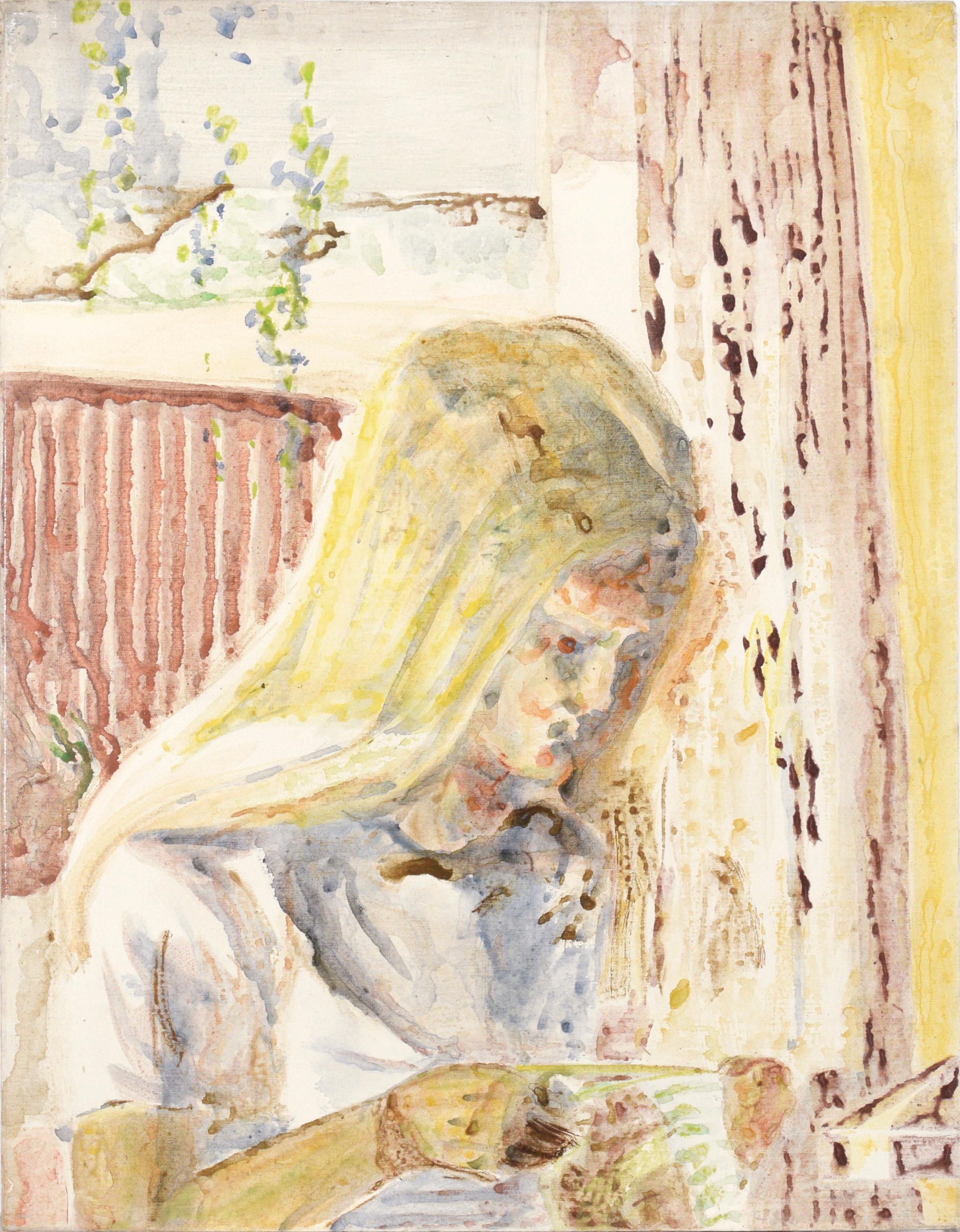Items Similar to Rare Modernist Oil Painting Line Drawing Nude Man Louis Stettner
Want more images or videos?
Request additional images or videos from the seller
1 of 11
Louis StettnerRare Modernist Oil Painting Line Drawing Nude Man Louis Stettner2011
2011
About the Item
Signed and Dated Modern Line Drawing Oil Painting of Nude Man.
Louis Stettner (November 7, 1922 – October 13, 2016) was an American photographer of the 20th century whose work included streetscapes, portraits and architectural images of New York and Paris. His work has been highly regarded because of its humanity and capturing the life and reality of the people and streets. Starting in 1947, Stettner photographed the changes in the people, culture, and architecture of both cities. Stettner also spent significant time sculpting and painting, as well as mixing his work and “painting” on some of his photographic images. He continued to photograph New York and Paris up until his death.
Louis Stettner was born in Brooklyn, New York, to Austrian immigrant parents where he was one of four children. His father was a cabinet maker, and Louis learned the trade when young, using the money he earned to support his growing love of photography. He decides to be a photographer after seeing photographs by Alfred Stieglitz and Weegee. He was given a box camera as a child, and his love affair with photography began. His family went on trips to Manhattan and visited museums, including the Metropolitan Museum of Art, where his love of art began.
At 18, in 1940, Stettner enlisted in the United States army and became a combat photographer in Europe for the Signal Corps. After a brief stint in Europe he was sent to New Guinea, the Philippines, and Japan. Back from the war he joined the Photo League in New York. Through the Photo League’s exhibits, Stettner was further exposed to the work of Weegee, Edward Weston, and Lewis Hine. Stettner visited Paris in 1946 and in 1947 moved there. From 1947 to 1949 he studied at the "Institut des Hautes Études Cinématographiques" in Paris and received a Bachelor of Arts in Photography & Cinema. He went back and forth between New York and Paris for almost two decades and finally settled permanently in Saint-Ouen, near Paris, in 1990. Stettner still frequently returned to New York.
Stettner's professional work in Paris began with capturing life in the post-war recovery. He captured the everyday lives of his subjects. In the tradition of the Photo League, he wanted to investigate the bonds that connect people to one another. In 1947 he was asked by the same Photo League to organize an exhibition of French photographers in New York. He gathered the works of some of the greatest photographers of the era, including Robert Doisneau, Brassaï, Edouard Boubat, Izis Bidermanas, and Willy Ronis. The show was a big success and was largely reviewed in the annual issue of U.S. Camera. Stettner had begun a series of regular meetings with Brassaï who was a great mentor and had significant influence on his work. In 1949, Stettner had his first exhibition at the "Salon des Indépendants" at the Bibliothèque Nationale, Paris.
In 1951 his work was included in the famous Subjektive Fotografie exhibition in Germany. During the 1950s he free-lanced for Time magazine, Life, Fortune, and Du (Germany). While in Paris he reconnected with Paul Strand, who had also left New York because of the political intolerance of the McCarthy era—Strand had been a founder of the Photo League that would be blacklisted and then banned during those years.
In the 1970s Stettner spent more time in New York City, where he taught at Brooklyn College, Queens College, and Cooper Union.
In his own social realist work, Stettner focused on documenting the lives of the working class in both Paris and New York. He felt that the cities belong to the people who live there, not to tourists or visitors. His upbringing caused him to take great care in capturing the simple human dignity of the working class. He also captured noteworthy architectural images of both cities, including bridges, buildings, and monuments. Stettner produced well-known silver gelatin prints in fine images, including: Aubervilliers, Brooklyn Promenade, Twin Towers with Sea Gull, Penn Station, and the Statue of Liberty, Battery Park. He also worked in oil paint and bronze cast sculpture as well as wood carved sculpture with an African American look to them. Many nudes but not particularly erotic.Throughout his prolific career, Louis Stettner, a force of nature with a Whitmaneque passion for life and the inquiring mind of a philosopher, interacted with and was befriended by many of the most significant photographers of the Humanist school of photography of the 20th Century: Stieglitz, Brassai, Strand, Weegee, Cartier-Bresson, Sid Grossman, Lou Faurer, Lisette Model, Boubat, among many others. The encouragement of fellow photographers, whose reflections and critiques of his work Stettner profoundly valued, was to reinforce a life-time passion, that of grasping the significance of life and reality around him.
Stettner also received numerous honors, and in 1950 he was named Life's top new photographer. In 1975 he won First Prize in the Pravda World Contest.
Museums containing work by Stettner
Addison Gallery of American Art, Phillips Academy, Andover, MA
Art Institute of Chicago, Chicago
Bibliothèque historique de la ville de Paris
Bibliothèque Nationale de France, Paris
Brooklyn Museum of Art, Brooklyn
Cleveland Museum of Art, Cleveland
International Center of Photography, New York
Jewish Museum Berlin
Los Angeles County Museum of Art - LACMA, Los Angeles
Maison Européenne de la Photographie, Paris
Merrill Lynch Art Collection, New York
Metropolitan Museum of Art, New York
Microsoft Art Collection, Seattle
Montana Museum of Art and Culture, Missoula, MT
Carnavalet Museum, Paris
Museum of Fine Arts, Boston
Musée de l'Élysée, Lausanne
Musée de l'Elysee, Paris
Museum of Modern Art, New York
Museum of the City of New York
New Britain Museum of American Art New Britain, Connecticut
New York Public Library, New York
San Francisco Museum of Art, San Francisco
San Francisco Museum of Modern Art, San Francisco
Smithsonian Institution, Washington, DC
Victoria and Albert Museum, London
Whitney Museum of Art, New York
Select exhibitions
Louis Stettner, Limelight Gallery, August 17-September 27 1954
What's New: Recent Acquisitions in Photography. Whitney Museum of American Art, New York,
Star Spangled Spirit. Bonni Benrubi Gallery, New York, 2002
City Streets. Samuel P. Harn Museum of Art, Gainesville, Fla, 2003
Photographies récentes par Louis Stettner. Galerie Marion Meyer, Paris, 2003
Full House: Views from the Whitney's Collection at 75. Whitney Museum of American Art
Louis Stettner: Photographien. Camera Work, Berlin, 2006
Louis Stettner: Streetwise. Bonni Benrubi Gallery, New York, 2006
Fotografía Contemporánea. Museo Nacional de Bellas Artes, Santiago, 2006
Selected books and portfolios
Paris-New York. Paris, New York: Two Cities Publications, 1949. Portfolio of 10 photographs, introduction by Brassaï.
Workers: Twenty-Four Photographs. New York: Stettner Studio, 1974. Portfolio.
Women. New York: Stettner Studio, 1976. Portfolio of 22 photographs.
Sur le Tas. Paris: Cercle d'Art, 1979. ISBN 2-7022-0129-6. Book of 156 photographs, introduction by François Cavanna. (in French)
Early Joys: Photographs from 1947-1972. New York: Janet Iffland, 1987. Introduction by Brassaï.
Louis Stettner: New York, 1994. Kempen, New York: Te Neues; Paris, Flammarion, 1993.
Sous le ciel de Paris. Paris: Parigramme, 1994. Introduction by François Cavanna. (in French)
Louis Stettner's New York, 1950s–1990s. New York: Rizzoli, 1997. ISBN 0-8478-2004-1.
Louis Stettner: American photographer, Paris: Suermondt-Ludwig-Museum Aachen, 11. Januar-9. März 1997. Aachen: Museum der Stadt Aachen, Suermondt-Ludwig Museum, 1997.
Louis Stettner. Collection Photo Poche. Paris: Nathan, 1998. Introduction by François Bernheim.
Louis Stettner: Wisdom Cries Out in the Streets. Paris: Flammarion, 1999.
Louis Stettner: Sophisme, photographies 1990–1999. Neuchâtel: Ides et Callendes, 1999. Text by Michèle Auer.
Chile en el corazón. Santiago: LOM, 2001.
elected essays and books by Louis Stettner
De "l'objectivité nouvelle" à la "photographie subjective". Antwerp: Gevaert, 1953.
35 mm Photography, editor. U.S. Camera Co., 1956.
History of the Nude in American Photography, editor. New York: Fawcett, 1966.
Weegee the Famous, editor. New York: Knopf, 1978.
"Cézanne's Apple and the Photo League," Aperture, no. 112 (Fall 1988), pp. 14–35
- Creator:Louis Stettner (1922, American)
- Creation Year:2011
- Dimensions:Height: 32 in (81.28 cm)Width: 25.5 in (64.77 cm)
- Medium:
- Movement & Style:
- Period:
- Condition:good. minor wear.
- Gallery Location:Surfside, FL
- Reference Number:1stDibs: LU3824696962
About the Seller
4.9
Platinum Seller
These expertly vetted sellers are 1stDibs' most experienced sellers and are rated highest by our customers.
Established in 1995
1stDibs seller since 2014
1,541 sales on 1stDibs
Typical response time: 1 hour
- ShippingRetrieving quote...Ships From: Surfside, FL
- Return PolicyA return for this item may be initiated within 3 days of delivery.
More From This SellerView All
- Simka Simkhovitch WPA Artist Painting Gouache American Modernist Beach SceneBy Simka SimkhovitchLocated in Surfside, FLSimka Simkhovitch (Russian/American 1893 - 1949) This came with a small grouping from the artist's family, some were hand signed some were not. These were studies for larger paintings. Simka Simkhovitch (Симха Файбусович Симхович) (aka Simka Faibusovich Simkhovich) (Novozybkov, Russia May 21, 1885 O.S./June 2, 1885 N.S.—Greenwich, Connecticut February 25, 1949) was a Ukrainian-Russian Jewish artist and immigrant to the United States. He painted theater scenery in his early career and then had several showings in galleries in New York City. Winning Works Progress Administration (WPA) commissions in the 1930s, he completed murals for the post offices in Jackson, Mississippi and Beaufort, North Carolina. His works are in the permanent collections of the Dallas Museum of Art, the National Museum of American Art and the Whitney Museum of American Art. Born outside Kyiv (Petrograd Ukraine) into a Jewish family who owned a small department store. During a severe case of measles when he was seven, Simcha Simchovitch sketched the views outside his window and decided to become an artist, over his father's objections. Beginning in 1905, he studied at the Grekov Odessa Art School and upon completion of his studies in 1911 received a recommendation to be admitted to the Imperial Academy of Arts. Though he enrolled to begin classes in architecture, painting, and sculpture at the Imperial Academy, he was dropped from the school roster in December because of the quota on the number of Jewish students and drafted into the army. Simchovitch served as a private in the 175th Infantry Regiment Baturyn [ru] until his demobilization in 1912. Re-enrolling in the Imperial Academy, he audited classes. Simka Simkhovitch exhibited paintings and sculptures in 1918 as part of an exhibition of Jewish artists and in 1919 placed 1st in the competition "The Great Russian Revolution" with a painting called "Russian Revolution" which was hung in the State Museum of Revolution. In 1922, Simkha Simkhovitch exhibited at the International Book Fair in Florence (Italian: Fiera Internazionale del Libro di Firenze). In 1924, Simkhovitch came to the United States to make illustrations for Soviet textbooks and decided to immigrate instead. Initially he supported himself by doing commercial art and a few portrait commissions. In 1927, he was hired to paint a screen for a scene in the play "The Command to Love" by Fritz Gottwald and Rudolph Lothar which was playing at the Longacre Theatre on Broadway. Art dealers began clamoring for the screen and Simkhovitch began a career as a screen painter for the theater. Catching the attention of the screenwriter, Ernest Pascal, he worked as an illustrator for Pascal, who then introduced him to gallery owner, Marie Sterner. Simkhovitch's works appeared at the Marie Sterner Gallery beginning with a 1927 exhibit and were repeated the following year. Simkhovitch had an exhibit in 1929 at Sterner's on circus paintings. In 1931, he held a showing of works at the Helen Hackett Gallery, in New York City and later that same year he was one of the featured artists of a special exhibit in San Francisco at the California Palace of the Legion of Honor in Lincoln Park. The exhibit was coordinated by Marie Sterner and included four watercolors, including one titled "Nudes". He is of the generation of Russian Soviet artists such as Isaac Pailes, Serge Charchoune, Marc Chagall, Chana Orloff, Isaac Ilyich Levitan, and Ossip Zadkine. In 1936, Simkhovitch was selected to complete the mural for the WPA Post office project in Jackson, Mississippi. The mural was hung in the post office and courthouse in 1938 depicted a plantation theme. Painted on the wall behind the judge’s bench, “Pursuits of Life in Mississippi”, a depiction of black workers engaged in manual labor amid scenes of white professionals and socialites, was eventually covered over in later years during renovations due to its stereotypical African American imagery. Simka painted what he thought was typical of Jackson. His impression of pre-civil rights Mississippi was evidently Greek Revival column houses, weeping willow trees, working class families, and the oppression of African Americans. He painted African American men picking cotton, while a white man took account of the harvest and a white judge advised a white family, calling it Pursuits of Life in Mississippi. Though clearly endorsed by the government and initially generally well-received, the mural soon raised concerns with locals as the climate toward racial segregation began to change. The main concern was whether depictions that show African Americans in subjugated societal roles should be featured in a courtroom. The following year, his painting "Holiday" won praise at an exhibition in Lincoln, Nebraska. In 1940, Simkhovitch's second WPA post office project was completed when four murals, "The Cape Lookout Lighthouse and the Orville W. Mail Boat", "The Wreck of the Crissie Wright", "Sand Ponies" and "Canada Geese" were installed in Beaufort, North Carolina. The works were commissioned in 1938 and did not generate the controversy that the Jackson mural had. The main mural is "The Wreck of the Crissie Wright" and depicts a shipwreck which had occurred in Beaufort in 1866. "The Cape Lookout Lighthouse and the Orville W. Mail Boat" depicted the lighthouse built in 1859 and the mail boat that was running mail during the time which Simkhovitch was there. The boat ran mail for the area until 1957. "Sand Ponies" shows the wild horses common to the North Carolina barrier islands and "Canada Geese" showed the importance of hunting and fishing in the area. All four murals were restored in the 1990s by Elisabeth Speight, daughter of two other WPA muralists, Francis Speight...Category
1930s American Modern Nude Paintings
MaterialsGouache, Board
- Simka Simkhovitch WPA W/C Painting Gouache American Modernist Beach Scene NudeBy Simka SimkhovitchLocated in Surfside, FLSimka Simkhovitch (Russian/American 1893 - 1949) This came with a small grouping from the artist's family, some were hand signed some were not. These were studies for larger paintings. This is a watercolor and gouache beach scene three young men bathing...Category
1930s American Modern Nude Paintings
MaterialsWatercolor, Gouache, Board
- Nude Mermaid Under Sea, German Outsider Folk Art OIl PaintingBy Hajo MalekLocated in Surfside, FLFantasy Nude Mermaid German outsider Naive artist born in 1922. has exhibited in Germany in 1969 worked in painting, gouache and linocuts. Expressionist Folk Art style. Art brut, pr...Category
1990s Outsider Art Figurative Paintings
MaterialsCanvas, Oil
- 2 Sided Expressionist Detroit Modernist Painting Female Nude, Night Cruise ShipLocated in Surfside, FLThis is a two sided painting. Nude reclining woman and a ship lit at night. Harold Cohn (1908 - 1982) Harold Cohn was active/lived in New Jersey, Michigan. Harold Cohn is known fo...Category
Mid-20th Century Modern Nude Paintings
MaterialsWatercolor, Gouache
- 2 Sided Expressionist Detroit Modernist Painting Female Nude, Night Cruise ShipLocated in Surfside, FLThis is a two sided painting. Nude reclining woman and a ship lit at night. Harold Cohn (1908 - 1982) Harold Cohn was active/lived in New Jersey, Michigan. Harold Cohn is known fo...Category
Mid-20th Century Modern Nude Paintings
MaterialsWatercolor, Gouache
- American Modernist Oil Painting Gestural Landscape WPA Artist Group of 10By Ben-Zion WeinmanLocated in Surfside, FLBorn in 1897, Ben-Zion Weinman celebrated his European Jewish heritage in his visual works as a sculptor, painter, and printmaker. Influenced by Spinoza, Knut Hamsun, and Wladyslaw Reymont, as well as Hebrew literature, Ben-Zion wrote poetry and essays that, like his visual work, attempt to reveal the deep “connection between man and the divine, and between man and earth.” An emigrant from the Ukraine, he came to the US in 1920. He wrote fairy tales and poems in Hebrew under the name Benzion Weinman, but when he began painting he dropped his last name and hyphenated his first, saying an artist needed only one name. Ben-Zion was a founding member of “The Ten: An Independent Group” The Ten” a 1930’s avant-garde group, Painted on anything handy. Ben-Zion often used cabinet doors...Category
Mid-20th Century Expressionist Figurative Paintings
MaterialsOil, Wood Panel
You May Also Like
- “Woman with Birds”By Nahum TschacbasovLocated in Southampton, NYOriginal mid-century modern oil on canvas board painting of a woman with birds by the well known Russian/American artist Nahum Tschacbasov. Signed and ...Category
1950s American Modern Nude Paintings
MaterialsOil, Canvas
- Queen of the Night, narrative, partial nude figure, red colors, ethnic fabricsBy Audrey AnastasiLocated in Brooklyn, NYABOUT the artist: Audrey Frank Anastasi is a prolific feminist artist, working in painting, drawing, collage, mixed media, & printmaking. She is also curator, gallerist, educator and arts advocate. Most of Ms. Anastasi's figurative works are painted with her non-dominant left hand. She has created large bodies of works of birds, animals and birch trees. She has had 20 solo & 200 group shows. Her "ref-u-gee" series will be shown in 2020 at Medgar Evers College in collaboration with the Valentine Museum of Art, Brooklyn. Accompanying the show will be a limited-edition monograph w/ over 180 images and a foreword by Phyllis Braff. Ms. Anastasi's collage series was exhibited at Welancora Gallery, Brooklyn, in May, 2019. In 2018, ten paintings were exhibited in "Painting to Survive," curated by Yale critic Jonathan Weinberg. Book and catalog publications include "Stations of the Cross", SPQR press, BREUCKELEN magazine, “Audrey Frank Anastasi”, catalog essay Cindy Nemser, and "Collage," essay by Giancarlo T. Roma. Public art includes a portrait of Jo Davidson...Category
2010s American Modern Figurative Paintings
MaterialsCanvas, Oil
- "Cowboy Boots" - Bay Area Figurative MovementBy Patricia Gren-HaynesLocated in Soquel, CABay Area School figurative of a cowboy and hats by Berkeley artist Patricia Gren Hayes (American, b- 1932), circa 1983. Signed "Gren Hayes 1983" upper center and signed and titled "Cowboy Boots" on verso. Unframed. Size: 16"H x 20"W. Bay Area Figurative...Category
1980s American Modern Figurative Paintings
MaterialsCanvas, Oil
- Parisian ModelBy Max WeberLocated in Palm Desert, CA"Parisian Model" is an oil on canvas painting by Max Weber painted in 1908. The work is signed and dated, lower right, "Max Weber Paris 1908". The painting size is 35 1/2 x 19 5/8 inches. The framed size is 43 x 27 x 2 1/4 inches. "Parisian Model" was painted in 1908, when Weber participated in a life class in Matisse's studio in Paris and painted several nudes. Weber was influenced toward a more Cubist styler after seeing Cezanne's work in the 1906-07 Salon in Paris, and he consorted within avant-garde circles in Paris as early as 1905. After returning to the US in 1909, Weber was credited with showing American audiences Cubism based on his firsthand knowledge of the key players and the style. Several drawings of Weber's from this time are in museum collections at The Met, the Smithsonian, and MoMA and show a similar style and stocatto gesture. Parisian paintings by Max Weber are extremely rare as there are hardly any that have sold publicly. Provenance: Estate of the Artist Gerald Peters Gallery...Category
Early 20th Century American Modern Nude Paintings
MaterialsCanvas, Oil
- Woman in Bloom - Figurative Nude Study Oil on CanvasBy Patricia Gren HayesLocated in Soquel, CAWoman in Bloom - Figurative Nude Study Oil on Canvas A nude woman, seemingly pregnant, sits reclined in a chair with her hands at the base of her belly holding a flower. This striki...Category
Mid-20th Century American Modern Figurative Paintings
MaterialsCanvas, Oil
- "Rosemary" Berkeley Figurative School by Patricia Gren Hayes 1980By Patricia Gren HayesLocated in Soquel, CA"Rosemary" Berkeley Figurative School by Patricia Gren Hayes 1980 A large scale portrait of a blond woman by Patricia Gren Hayes (b. 1932). The model is in front of a window, with h...Category
1980s American Modern Figurative Paintings
MaterialsCanvas, Oil
